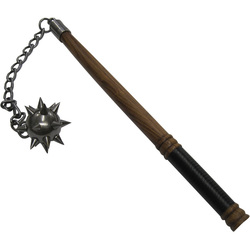Guy argues that the flail we all know and love, mostly from D&D never was used in battle. He makes a number of points.
More at the link
http://www.publicmedievalist.com/cur...n-didnt-exist/
Let’s look at the evidence.
Firstly, as a weapon of war, the flail is not a good design. The element that makes a flail unique—its chain—is the biggest drawback. The chain and swinging ball make this theoretical weapon extremely difficult to control. In a tightly packed formation, a swinging weapon would be as likely to brain your fellow soldiers as it would your enemies. If it were to rebound, say off a shield or even a successful strike, it would be likely to hit you. God help you if you miss, and hit yourself or the thing flies out of your hand.
And in terms of physics, the swing certainly gives the metal ball a higher speed than the head of, say, a similar mace. However, the mace, being rigid, allows the fighter to follow through the swing with their whole body. Any follow-through with a flail would just make the potentially disastrous rebound hit you even harder. Also, the chain is a weak point that could break or be broken by your enemy, or find itself wrapped around their sword, or the handle of a larger weapon.
“But wait,” you may ask, “what about those flails at the Met that you just mentioned?” This is where the story gets interesting. My working hypothesis is that all the flails at the Met, and those in similar collections occasionally found elsewhere in the world, are, as Warner asserted so bluntly, fakes.
I call this a hypothesis because I have not (and likely will never) examine every single one. And, the possibility that fakes can exist in museum collection sets many curators’ teeth on edge. The art world has acknowledged (and even occasionally celebrated) the fakes in their museum collections for decades now. But history museums have been far slower, generally quietly correcting their catalogues rather than taking this particular bull by its horns. To their credit, due to the questions over their provenance the Met no longer displays their flails in the museum.
I looked at the Met’s flails with the help of Dr. Nickolas Dupras, an expert in medieval arms and armour.
This one, Dr. Dupras, says, takes its form from a horsewhip (a “goad”) instead of a military weapon.
“The chains look relatively flimsy,” Dr. Dupras said, “these three-ball flails are based on manuscript illustrations depicting early ‘cat-o-nines’ or whips, also depicted as instruments of torture in Passion and martyrdom illustrations.” It’s important to note as well that a real goad would have been made of wood and rope—why this one, a copy of the form, is made of steel is unclear.
The next one in the Met’s collection is very different, with very fine workmanship.
The flail is not a weapon so much as it is an icon. It exists, and will continue to exist, because it so vividly paints the Middle Ages not as it was, but as we believe it to have been. That the medieval military flail exists at all is probably the most fascinating thing about it.
Thread: The military flail didn't exist
-
2016-05-17, 06:05 PM #1
The military flail didn't exist
.
"This will be a fight against overwhelming odds from which survival cannot be expected. We will do what damage we can."
-- Capt. Copeland
-
2016-05-17, 06:10 PM #2Deleted
Sounds reasonable. I'd never want to fight someone with this. Give me a sword or an axe.
-
2016-05-17, 06:10 PM #3Deleted
The flail is great in single combat like a tourney or duel, not good in mass combat like a battlefield because it needs a lot of space to be swung, which doesn't happen that much in a battle, especially not in a bottleneck, rendering it useless or hitting your own men.
The sword is the best weapon for battlefields because it can be swung but also used to stab with if the opponent is too close.
-
2016-05-17, 06:10 PM #4Deleted
Wouldn't it be quite good on horseback? Be free of the force that would go through your arm, every time you hit someone with a full object, but still maintain quite deadly power.
-
2016-05-17, 06:14 PM #5
It is a pretty intimidating weapon. Might have been used more in the City Guard than on the battle field. Wearing no armor, that thing would mess someone up pretty bad. If the Guard was using these, I wouldn't want to mess with them. They would also be difficult to defend against by serfs using simple weapons. A dagger can defend against a long sword, but I don't see a dagger defending against a flail.
I'd have to confirm with my HEMA professors to see where they stand on Flails.
- - - Updated - - -
I could see it being used on Horse Back in battle, but not on foot, for the reasons you stated. On horse back, you can get away with low swings at soldiers heads.
- - - Updated - - -
This is what i'm thinking too.RIP Genn Greymane, Permabanned on 8.22.18
Your name will carry on through generations, and will never be forgotten.
-
2016-05-17, 06:14 PM #6There is a cult of ignorance in the United States, and there always has been. The strain of anti-intellectualism has been a constant thread winding its way through our political and cultural life, nurtured by the false notion that democracy means that “my ignorance is just as good as your knowledge." - Isaac Asimov
-
2016-05-17, 06:14 PM #7
-
2016-05-17, 06:15 PM #8
-
2016-05-17, 06:15 PM #9
-
2016-05-17, 06:17 PM #10
I'd be very curious to see the time range in which lances were used, and when flails were supposedly used.
During the middle ages, it was a rapid arms race, and may weapons had a pretty short life span in combat as people were always looking to build the counter weapon to the enemies armaments.
- - - Updated - - -
Indeed. And it totally sucks to have your chest armor caved in, making it hard, or impossible to breath.RIP Genn Greymane, Permabanned on 8.22.18
Your name will carry on through generations, and will never be forgotten.
-
2016-05-17, 06:17 PM #11
If anyone wants some videos on flail type weapons here are a few from Lindybeige:
https://www.youtube.com/watch?v=O-y6oirEsZA
https://www.youtube.com/watch?v=RjzE8YMkC5s
https://www.youtube.com/watch?v=UGv_UdgHeCQ
What may have been used on rare occasion is something like the following:

An agricultural flail used for threshing. It's possible that some farmers may have used these as weapons as they had them to hand and they're better than nothing.
In most situations though you would probably have been better off with a sword, spear, axe, hammer or many other options.
In Eastern Mediterranean Europe and the Middle East it seems around the 3rd century BC. Basically the sides that get the best cavalry in ancient/medieval RTS games - they used lances from then pretty much onwards.Last edited by klogaroth; 2016-05-17 at 06:23 PM.
-
2016-05-17, 06:17 PM #12Deleted
-
2016-05-17, 06:17 PM #13
I've heard this theory before... I suppose it might be true: flail just isn't very effective; just a spiked mace is much quicker and easier to use, while not losing much in the damage potential department (in fact, even gaining, in some sense, since, like mentioned above, the warrior has a better control over mace and can swing with his entire body through the enemy's armor).
However, in this case, I would cite Voltaire with a slight twist: "If flail did not exist, it would be necessary to invent it".
-
2016-05-17, 06:18 PM #14
-
2016-05-17, 06:19 PM #15
Chain weapons, if I'm not mistaken, are generally used in 1 on 1 circumstances when you can reliably count on their surprise factor. Not to mention they tend to be more flashy, you'd expect to see them in spectator sports more than anything.
-
2016-05-17, 06:21 PM #16Deleted
-
2016-05-17, 06:21 PM #17The Insane


- Join Date
- Aug 2011
- Posts
- 15,873
I'd think such a thing would be used exclusively against lightly armed soft targets such as unruly civilians. As Lemposs eluded to the chain would actually provide a considerable reduction in strain to the user over a mace or a sword.
So if you aren't in any real danger but want to put somebody down without worrying about a sore elbow later on it seems like it would actually be a decent choice.
-
2016-05-17, 06:22 PM #18
I always preferred spears, it's all about the reach.



-
2016-05-17, 06:23 PM #19
One thing we learned in Historical European Martial Arts, is how to defend against a sword with a dagger. Simple weapons can be effective. A flail would be difficult to defend against with something like a dagger.
Dagger & Buckler is a very effective method of fighting against swords. Flails would use brute force to get past the defenses.RIP Genn Greymane, Permabanned on 8.22.18
Your name will carry on through generations, and will never be forgotten.
-
2016-05-17, 06:26 PM #20

 Recent Blue Posts
Recent Blue Posts
 Recent Forum Posts
Recent Forum Posts
 New heritage armors (Draenei and Troll) are not acceptable
New heritage armors (Draenei and Troll) are not acceptable MMO-Champion
MMO-Champion



 Reply With Quote
Reply With Quote


